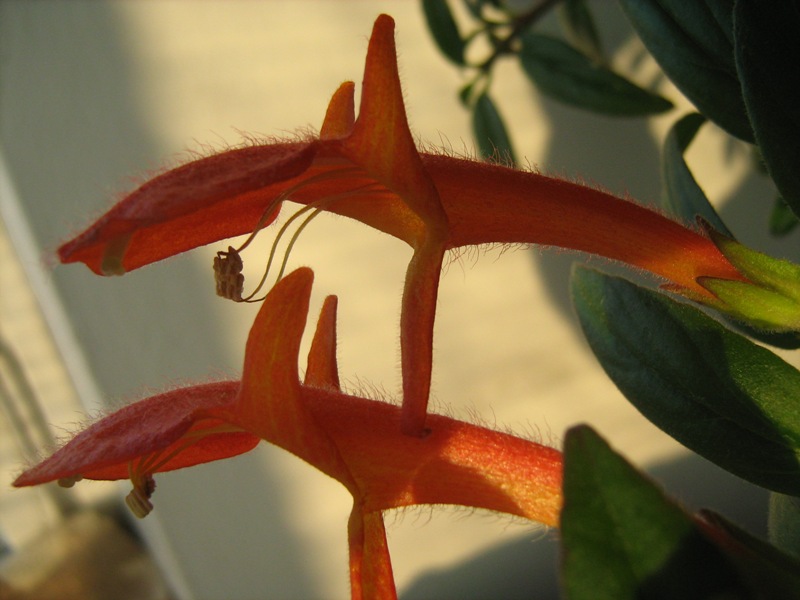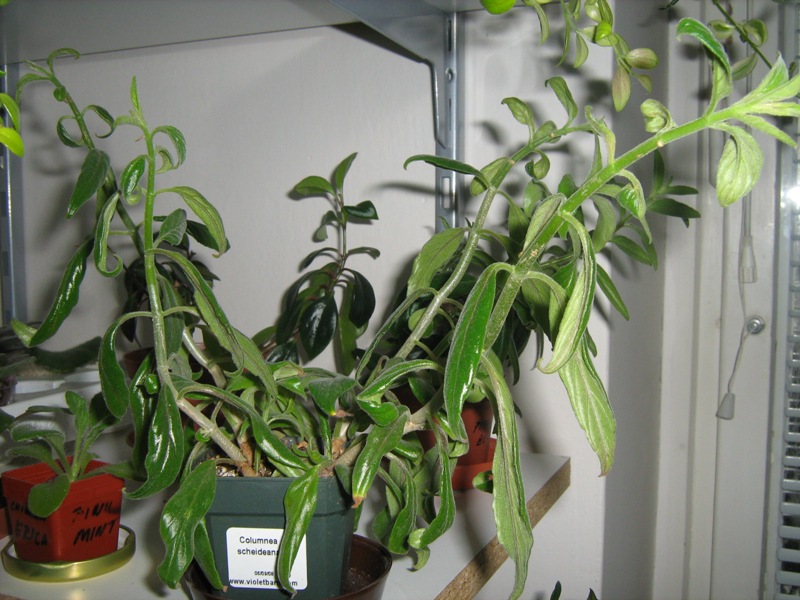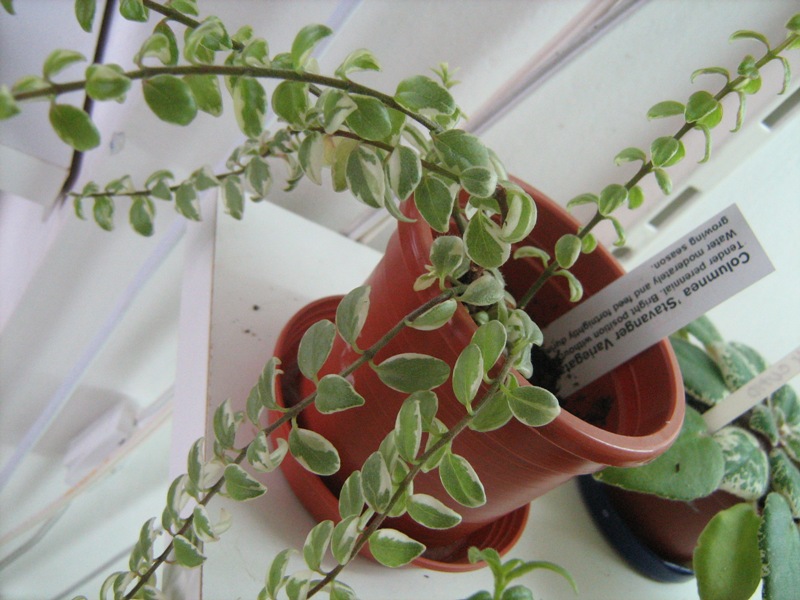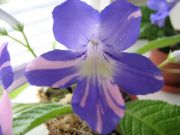|
|
Gesneriads with Fibrous Roots Only
A e s c h y n a n t h u s
Aeschynanthus is a genus of ca. 185 species of tropical herbs. They are found in southern and southeastern Asia, the islands of Indonesia, New Guinea, and the Philippines. They are usually trailing epiphytes with brightly colored flowers that are pollinated by sunbirds. Among the better known species are Aeschynanthus lobbianus and Aeschynanthus radicans. The genus name comes from a contraction of aischuno (to be ashamed) and anthos (flower). The common name for some species is "lipstick plant", which comes from the appearance of the developing buds of some species. A full list of the accepted species and their synonyms can be found in the Smithsonian Institution's World Checklist of Gesneriaceae.
The genus contains a large variety of plants with differing features. Some have thick, waxy cuticles (as in A. lobbianus) others have much softer leaves (as in A. hildebrandii). Species such as A. speciosus are large where A. micranthus is much smaller and trailing.
(From Wikipedia, the free encyclopedia)
plants from my collection:
A. marmoratus A. Twister
A. marmoratus (synonym: Aeschynanthus zebrinus). The zebra basket vine is uncommon but well worth looking for. It is grown for its foliage rather than its dull green flowers - the leaves are intricately mottled above and dark red below. Easy-to-grow plant.
A. Twister - owes its name to its ornamental leaves that curl both along their length and breadth. The plant also has an unusually compact growth habit and this makes ‘Twister’ look much fuller than would normally be expected. The flowers with their deep scarlet colour that are hidden at the ends in dark, almost violet little shafts come out after a few weeks in full splendour and unfold in groups of 8 to 12 flowers a twig at the same time. This variety is a mutant of Aeschynanthus ‘Rasta’
Nematanthus - another genus from South America - is a genus of flowering plants of the family Gesneriaceae. Compared to other gesneriads, Nematanthus has leaves that are small, succulent, and hard-surfaced. The plant has a trailing, branching, and spreading habit; it is generally an epiphyte in nature and a hanging-basket plant in cultivation.
The flower has petals fused into a pouch-like shape, with a small opening. The fancied resemblance of the flower to a goldfish gives the plant its common name, "goldfish plant."
Hummingbirds often will feed from the nectar-filled "goldfish" flowers.
(From Wikipedia, the free encyclopedia)
plants from my collection:
N. tropicana N. Salou N. radicans
??? ??? N. Albus (Santa Theresa)
N. Tropicana (Saylor) - Very unusual. Eye-catching yellow-gold blooms striped with gold and dark maroon-red. Upright growing, very dark foliage. Very interesting blooms have look of "tiger stripes". Vigorous, easy grower and bloomer once mature.
N. Salou -
N. radicans - A very attractive light variegated plant with very glossy leaves. The plant forms a nice spreading shape with attractive amber flower.
N. sp. Albus (Santa Theresa) - Huge white blooms with throat heavily spotted yellow. Dark, red-backed foliage. Upright grower. Produces unusual seed pods too! One of the most unusual and wonderful plants.
and a few no name plants...
Columnea is a genus of ca. 200 species of epiphytic herbs and shrubs in the flowering plant family Gesneriaceae, native to tropical America and the Caribbean. The tubular or oddly shaped flowers are usually large and brightly colored – usually red, yellow, or orange –, sometimes resembling a fish in shape. A common name is flying goldfish plants (see also the related Nematanthus) due to the unusual flower shape.
The segregate genus Bucinellina is considered by many botanists a synonym of Columnea. A full list of the species now accepted in the genus, along with their synonyms, can be found at the World Checklist of Gesneriaceae.
(From Wikipedia, the free encyclopedia)
plants from my collection:
  
C. Krakatau C.Scheideana C. Stavanger Variegata
C. Sundancer C. Sylvia
C. Krakatau -
C. Scheideana - Very unusual blooms of brick-red with yellow-green veins-or more often, green with brick-red mottling and streaks. Spreading growth habit of unequal green leaves.
C. Stavanger Variegata - Very vigorous plant with attractive variegated foliage, branches freely and makes a lovely hanging plant . Red flowers with a yellow throat.
C. Sundancer - Loads of large, bright yellow blooms and small, dark bronze-green leaves with semi-cascading habit. Terrific example of its color.
C. Sylvia (Kartuz) - Narrow, pointed leaves with unusual, salmon-pink blooms. Thick stems, upright grower.
These very easy to grow, cascading gesneriads have small, somewhat succulent, leaves and short, trumpet-like blooms. Size of plant determined by how they are pruned by grower. They will grow and bloom almost constantly, even when neglected a bit.
xCodonatanthus - Pretty trailing plants that have been produced by crossing Codonanthe and Nematanthus
plants from my collection:
C. Golden Tambourine
C. Golden Tambourine - Beautiful golden yellow variegated trailing foliage, with masses of cream and rose pink flowers most of the year. A lovely sport.
Chirita is an Old World genus of the flowering plant family Gesneriaceae. There are currently about 150 species recognised in the genus, about 100 of which are endemic to China. Most of the species have showy flowers and are becoming increasingly popular as houseplants, much like their cousins the African violets.
(From Wikipedia, the free encyclopedia)
plants from my collection:
Ch. chastity Ch. Little dragon Ch. Tamiana
Ch. Vietnam (usbrg #98-083) Ch. Aiko Ch. Kitaguni
Ch. Keiko
Ch.Erika Ch.Hisako Ch.spadiciformus
Ch.Stardust Ch.Betty Ch.liboensis Ch.periwinkle
Ch. Aiko (Okuto) - Bright yellow blooms over quilted, medium green, foliage. Compact grower and an excellent bloomer.
Ch. Betty - Very striking, beautiful, silver foliage banded in green. Lavender blooms. Easy grower and likely the prettiest colored foliage of all.
Ch. brassicoides -
Ch. Chastity - (Boggan) Smooth mid green leaves form a rosette from which multiflowering stems appear. The flowers are medium sized and the leaves are small.
Ch. Erika -
Ch. Hisako - (Nakayama) One of the most beautiful of the chiritas. Easily grows into show quality foliage, that is dark green with silver veins. Lavender flowers.
Ch. Keiko - Deep velvet green, quilted leaves, are ovate and slightly serrated. Flowers are soft lavender blue, with white and yellow throats.
Ch. Kitaguni - Lots of bright yellow blooms above quilted, pointed, glossy foliage. Easy grower and bloomer.
Ch. latifolia dwarf - Very symmetrical, moderate-sized grower with thick, quilted, leaves and plenty of light blue blooms with yellow throat. Very easy grower and free bloomer.
Ch. liboensis - Bright green leaves, pink-lavender flowers. Compact.
Ch. Little Dragon - A wonderful little plant with thick, deep green, pointed foliage that grows in a perfect rosette of about 6" in diameter. Adorable little blooms of very pale lavender produced easily. When mature, will produce stolons, at ends of which are borne another plant! A newer, still scarce, hybrid.
Ch. periwinkle -
Ch. sclerophylla - A compact rosette of deep, forest green leaves, with a silvery to pale green center streak. Occasional blooms are violet.
Ch. spadiciformus - 'Spade' like flower bracts spread like wings. Light lavender blooms with large, white-yellow throat.
Ch. Stardust (Boggan) - Lavender blooms are veined darker purple throughout and with two bright yellow stripes on lower throat. Heavily veined silver, serrated, foliage. Easy grower and dependable bloomer.
Ch. Tamiana - A real miniature plant only recently collected in Vietnam. Similar in habit to a trailing Saintpaulia. This adorable little species will soon be grown by everyone who grows houseplants. Only recently in cultivation, it's perhaps the easiest to grow and bloom gesneriad one could have. Tiny, white blooms are striped purple in throat. Very small, miniature grower and very free bloomer.
Ch. sp. Vietnam (usbrg #98-083) - Long, narrow, pointed leaves have soft, velvet-like texture. Foliage forms a perfect rosette and produces lots of graceful stolons, at the end of which appear more plants! Round, pansy blooms are produced only one to a stem, but are a lovely shade of deep medium lavender-blue and have a clear, yellow throat.
Petrocosmea is a genus of the family Gesneriaceae, the African violet family. Most of the species within this genus are endemic to high-altitude areas in Western China, although some are native to other parts of Asia. It is a rosette forming genus that generally grows on wet mossy rocks or forests. Perhaps the relative of the African violet that most looks like one. Many are very new to cultivation. Nearly all have very well behaved foliage that grows in a perfect rosette. Most have soft, velvety, leaves. All will bloom easily.
The genus was discovered in China by Dr. Augustin Henry and was first described in 1887 by Daniel Oliver (Prof. Botany, University College, London
(From Wikipedia, the free encyclopedia)
plants from my collection:
P. barbata - Cute little 'wasp' shaped, powder-blue blooms with bright yellow center. Round, crinkle, soft and fuzzy foliage. Adorable plant, a dependable bloomer.
P. begonifolia - Very dark, almost black, very glossy and pebbled leaves make this different. Very flat, round, symmetrical grower. Nearly white blooms. Easy grower if not grown in excessive heat.
P. flaccida - Adorable deep blue-purple flowers are freely produced over very flat, symmetrical foliage. Leaves are medium green and covered with fine, silver hairs, especially in center of plant. Easy grower that blooms nearly all the time.
P. floribunda - Wonderful plant. Very pale lilac blooms with lighter face. Fuzzy, quilted, leaves make a nice rosette. Aptly named-blooms sporadically, but very heavily.
P. HT-2 - Very cuddly. Soft, round, thick foliage in perfect rosette. Baby blue blooms.
P. menglingensis - Pointed, very pebbly, glossy, tiny leaves that form in a perfect rosette. Tiny, pale lilac blooms.
P. rosettifolia - Tiny, pointed, glossy, very pointed leaves forming perfect rosette. Tiny blooms of light lavender blue, lighter and smaller upper petals, touch of yellow in throat.
Episcia is a genus of about 8 species belonging to the flowering plant family Gesneriaceae. The species are found in the tropical regions of Central America and South America (frequently cultivated elsewhere and sometimes naturalizing in tropical regions). The species are perennial herbaceous plants characterized by a stoloniferous habit, red (rarely orange, pink, blue or yellow) flowers, and frequently have marked or patterned leaves. They are grown in the tropics, and in temperate regions as houseplants, primarily for their attractive foliage. Numerous cultivars have been produced, primarily by selection and hybridization of the species E. cupreata and E. reptans.
For much of the Twentieth century Episcia had a broad circumscription but since 1978 has been restricted to a much narrower one, with the genera Paradrymonia, Chrysothemis, Nautilocalyx, and Alsobia separated from it. The segregation of these genera from Episcia has been supported in recent molecular phylogenies.
Episcias are sometimes called "Flame violets".
(From Wikipedia, the free encyclopedia)
plants from my collection:
Ep. fimbriata "Blue Heaven" - Unusual, fringed, light blue blooms with dark purple spots on cream throat. Very soft, fuzzy, medium green foliage.
Alsobia is a genus of flowering plants in the family Gesneriaceae, native to Mexico, Guatemala and Costa Rica.
The two species are succulent, stoloniferous herbs and were previously included in the genus Episcia. Recent molecular studies have supported the separation of Alsobia from Episcia.
Alsobias grow like a strawberry plant, producing lots of lush green foliage on stolons (that will root wherever they touch the soil). This makes for a lovely, full, plant even when not in bloom. The flowers have a deeply cut fringed edge, giving the name the lace plant.
(From Wikipedia, the free encyclopedia)
plants from my collection:
A. dianthiflora
A. dianthiflora - Small, lush, deep forest-green leaves and frilly white blooms. Extremely vigorous grower makes a great potted plant or hanging basket.
S t r e p t o c a r p u s
Streptocarpus is a genus of herbaceous flowering plants in the family Gesneriaceae, closely related to the genus Saintpaulia. One common name is Cape Primrose, referring to the nativity of several species to South Africa and their superficial resemblance to the genus Primula. The genus is native to parts of Africa and Madagascar (with a few odd species in Asia that probably do not belong in the genus). The plants often grow on shaded rocky hillsides or cliffs. About 155 species of Streptocarpus are currently recognized, the first described being S. rexii. They are found growing on the ground, rock crevices, and almost anywhere the seed can germinate and grow. Some species such as S. dunnii are unifoliate with the plant producing no true leaves, only a single cotyledon that continues to grow throughout the life of the plant. The unifoliate species are monocarpic and die after producing seeds. Other species are perennial and come into flower during different parts of the year. Members of subgenus Streptocarpella are more typical caulescent herbs and are sometimes grown as bedding or hanging plants. The genus is defined by having a spirally twisted fruit (hence the name "streptocarpus"), although this character is also found in some other Old World genera of Gesneriaceae. Recent phylogenetic studies strongly suggest that although it does not have a twisted fruit the genus Saintpaulia has evolved from within subgenus Streptocarpella.
The leaves of some perennial (and particularly unifoliate) Streptocarpus are unusual because as winter approaches they slowly die back to an abscission line midway down the leaf. The tip of the leaf will gradually die back to this line. In most flowering plants an absiscion line forms at the base of the leaf.
A complete list of the species and their synonyms can be found at the Smithsonian Institution's World Checklist of Gesneriaceae. The name Streptocarpus means twisted fruit.
A large number of hybrids and cultivars have been produced; S. rexii entered into many of the early hybrids but more recent cultivars often involve many different species. Recent cultivars have been bred to remain in bloom throughout the year. Over the past few years work has been done through hybridizing to bring other traits such as red flowers into modern hybrids. There are thousands of cultivars that are now grown as both houseplants and in the garden. The colors of the flowers range anywhere from red, white, yellow, blue, and everything in between including nearly black, except for a deep orange. Many flowers have markings in the "throat". More recently, breeders have been working to introduce floral fragrance to new hybrids from the relatively few species that have this trait.
Streptocarpus flowers are born on short and long peduncles (flower stems) that attach to the leaf stem. Several peduncles may be produced per leaf. New flowers come with new leaf growth.
Rosulate Streptocarpus form small clumps. As the plant grows it produces creeping stems that produce roots and will eventually separate to form other colonies. These creeping stems are called rhizomes.
(From Wikipedia, the free encyclopedia)
|
|
Saintpaulia, commonly known as African violet, is a genus of 6 species (Saintpaulia inconspicua, Saintpaulia goetzeana, Saintpaulia ionantha, Saintpaulia pusilla, Saintpaulia shumensis, Saintpaulia teitensis) of herbaceous perennial flowering plants in the family Gesneriaceae, native to Tanzania and adjacent southeastern Kenya in eastern tropical Africa, with a concentration of species in the Nguru mountains of Tanzania. The genus is most closely related to Streptocarpus, with recent phylogenetic studies suggesting it has evolved directly from subgenus Streptocarpella. The common name was given due to a superficial resemblance to true violets (Viola, family Violaceae).
The genus is named after Baron Walter von Saint Paul-Illaire (1860-1910), the district commissioner of Tanga province who "discovered" the plant in Tanganyika (now Tanzania) in Africa in 1892 and sent seeds back to his father, an amateur botanist in Germany. Two British plant enthusiasts, Sir John Kirk and Reverend W.E. Taylor, had earlier collected and submitted specimens to Royal Botanic Gardens, Kew in 1884 and 1887 respectively, but the quality of specimens was insufficient to permit scientific description at that time. The genus Saintpaulia, and original species S. ionantha, were scientifically described by J. C. Wendland in 1893.
Saintpaulias grow from 6-15 cm tall and can be anywhere from 6-30 cm wide. The leaves are rounded to oval, 2.5-8.5 cm long with a 2-10 cm petiole, finely hairy, and with a fleshy texture. The flowers are 2-3 cm diameter, with a five-lobed velvety corolla ("petals"), and grow in clusters of 3-10 or more on slender stalks (peduncles). Flower colour in the wild species can be violet, purple, pale blue, or white.
Several of the species and subspecies are endangered, and many more are threatened, due to clearance of their native cloud forest habitat for agriculture.
Revisions of the genus by B.L. Burtt had expanded the genus to approximately 20 species. On the basis of recent studies that showed most of the species to be very poorly differentiated, both genetically and morphologically, the number of species has been reduced to 6, with the majority of former species reduced to subspecies under S. ionantha, in a recent floristic treatment (Darbyshire 2006).
(From Wikipedia, the free encyclopedia)
|
|
|
|

